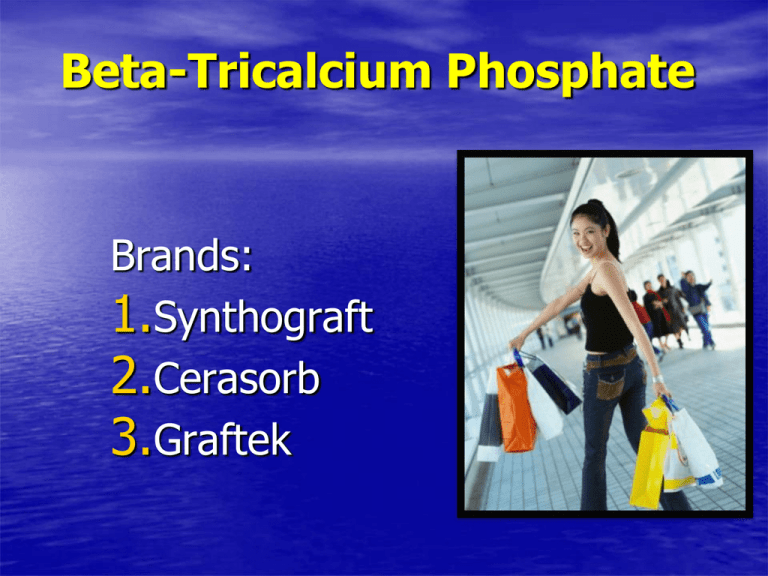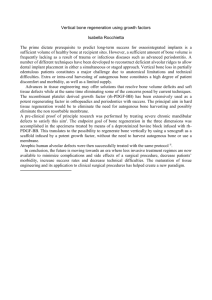Beta-Tricalcium Phosphate
advertisement

Beta-Tricalcium Phosphate Brands: 1.Synthograft 2.Cerasorb 3.Graftek Completely unique and synthetic, GEM 21S® is an innovative combination of a bioactive protein (highly purified recombinant human platelet derived growth factor, rhPDGF-BB) and a biocompatible osteoconductive matrix (beta-tricalcium phosphate, β-TCP) GEM 21S® contains 1000x more active growth factor (PDGF) than found in platelet rich plasma. Compared to bone graft substitute without PDGF Provides 3x more bone fill at 6 months Provides a more predictable treatment option even in the most severe cases “Sockets with intact buccal and lingual plates heal well without grafting… consider grafting with resorbable osteoinductive material if plates compromised and implants planned” grafting with connective tissue if pontic esthetics an issue.” Vital Root Retention • Never our first choice, but an option for preserving alveolar bone when performing full mouth extractions on young patients • Teeth must be vital with good periodontal health • Similar tooth selection as “conventional” overdentures, except elective endodontics not performed Vital Root Retention • Amputate teeth at crest, then remove 2 mm more tooth “sub osseous” • Consider grafting autogenous bone over tooth, then close primarily • Ideally, bone grows coronally over a vital, asymptomatic root • Depending on rate of alveolar resorption, will help preserve ridge 35 years before exposure/extraction Remove 2 mm tooth structure below bone Suture 2 mm New Bone Prosthesis J Oral Maxillofac Surg. 2005 Feb;43(1):7-12. A randomized controlled clinical trial to compare the incidence of injury to the inferior alveolar nerve as a result of coronectomy and removal of mandibular third molars. Renton T, Hankins M, Sproate C • The length of follow up was about two years, which for the assessment of delayed eruption of the root fragments is not sufficient as this process may continue for up to 10 years. However, it seems that coronectomy reduces the incidence of injury to the inferior alveolar nerve without increasing the risk of dry socket or infection. J Oral Maxillofac Surg. 2004 Dec;62(12):1447-52. Coronectomy: a technique to protect the inferior alveolar nerve. Pogrel MA, Lee JS, Muff DF. PURPOSE: Damage to the inferior alveolar nerve when extracting lower third molars is often caused by the intimate relationship between the nerve and the roots of the teeth. The technique of coronectomy, or intentional root retention, may minimize this problem. RESULTS: There were no cases of inferior alveolar nerve-involved damage in this study of 41 patients who underwent 50 coronectomies. There was 1 case of transient lingual nerve involvement, probably from the use of the lingual retractor. One patient required subsequent removal of the roots of both lower third molars because of failure to heal, and 1 patient required subsequent removal of a root because of subsequent migration to the surface. Root migration was noted in approximately 30% of patients over a 6 month period. CONCLUSION: Coronectomy appears to be a viable technique in those cases where removal of the whole tooth might put the inferior alveolar nerve at considerable risk of damage. Pre-op (Oral bisphosphonates X 5 years) Immed Post 10 month post Immediate Implant Placement Following Extractions • Need 3-4 mm of solid bone at base of socket, and no active infection • Success rates ~ to “normal” • Most typical sites: anterior teeth and 1st premolars • Advantages? May reduce loss of labial plate and improve esthetics, as well as save time Platelet Rich Plasma • What’s Hot – Release various growth factors that aid in hemostasis and increase rate of healing (mitogenesis, angiogenesis) • What’s Not – Cost – Is there any difference at 6 weeks? – Invasive, borrow 45-90ml of blood Casap et al. Immediate Implantation Into Debrided Infected Sockets. J Oral Maxillofac Surg 2007. Does placing implants into fresh extraction sockets preserve bone? J Clin Periodontol. 2005 Jun;32(6):645-52. Ridge alterations following implant placement in fresh extraction sockets: an experimental study in the dog. Araújo MG, Sukekava F, Wennström JL, Lindhe J. CONCLUSIONS: Marked dimensional alterations had occurred in the edentulous ridge after 3 months of healing following the extraction of the distal root of mandibular pre-molars. The placement of an implant in the fresh extraction site obviously failed to prevent the re-modeling that occurred in the walls of the socket. The resulting height of the buccal and lingual walls at 3 months was similar at implants and edentulous sites. Most human trials however, reveal results similar to implants place via the “old school” approach, even when immediately loaded (caution in “soft” bone, >55 Y/O) Int J Oral Maxillofac Implants. 2007 Mar-Apr;22(2):187-94. The radiographic bone loss pattern adjacent to immediately placed, immediately loaded implants. Jaffin R, Kolesar M, Kumar A, Ishikawa S, Fiorellini J. J Craniofac Surg. 2007 Jul;18(4):965-71. Immediate loaded dental implants: comparison between fixtures inserted in postextractive and healed bone sites. Degidi M, Piattelli A, Carinci F. J Periodontol. 2007 May;78(5):810-5. Vertical crestal bone changes around implants placed into fresh extraction sockets. Covani U, Cornelini R, Barone A Why Reconstruct? • Not enough bone for implants • Enough bone, but esthetic result suboptimal • Prevent pathologic fracture • Poor function/esthetics/retention of conventional removable prosthesis How? Autogenous Bone Grafts with Implants Autogenous Block Grafts • “Gold Standard” • Osteoinductive and Osteoconductive • No need for membranes • Holds form • Remodels into 100% high quality bone • No concerns about transmissible diseases Autogenous Block Grafts • Donor site morbidity • Quantity is limited • Lose 20-30% during healing Intra-oral Autogenous Bone Sites Allogenic Block Graft What about membranes? • Useful in containing particulate grafts • Useful around teeth/exposed implant threads • Add expense • Infection risk • Unnecessary with block grafts • ADA 4266 Resorbable • ADA 4267 Non-Resorbable Bone Morphogenic Protein (BMP) • Grow bone at will? • Presently two are FDA approved, BMP 2 for spinal fusions, and BMP 7 for long bone defects • Studies show excellent results for socket preservation, sinus lifts • Expensive ($5000.00 for a sinus) FDA Panel Unanimously Recommends Approval of Third Indication For Medtronic’s INFUSE Bone Graft Nov. 9, 2006. INFUSE Bone Graft is recombinant human bone morphogenetic protein-2 (rhBMP-2) applied to an absorbable collagen sponge carrier. The purpose of the protein, which occurs naturally in the body, is to stimulate bone formation. It has been previously approved by the FDA for use in certain lumbar spine fusion and tibial fracture repair procedures. Distraction Osteogenesis • Generation of bone (and soft tissue) through distraction of an osseous callus Ann N Y Acad Sci. 2006 Apr;1068:532-42. COX-2 has a critical role during incorporation of structural bone allografts. O’Keefe RJ, Tiyapatanaputi P, Xie C Nonsteroidal anti-inflammatory drugs (NSAIDs), which inhibit cyclooxygenase (COX) activity, reduce pain and are commonly used in patients with skeletal injury. In this article we will also present data to show that selective COX-2 inhibitor delays allograft healing and incorporation. These results demonstrated that COX-2 is essential for bone allograft incorporation. Furthermore, our data support the notion that COX-2dependent PGE2 produced at the early stage of bone healing is prerequisite for efficient skeletal repair. Wise Old Oral Surgeon Says Beware of: • 3rd molars in function • Lone standing molars • Teeth in bruxers/ Cl. III skeletal patterns • 3rd molars + post-menopausal women • Prior TMD history • Prior “bad” oral surgery experience • Distoangular lower 3rds/ nerve proximity 3rd Molar Surgery – Why? 1. 2. 3. 4. 5. 6. 7. Prevent/treat pericoronitis (infection) Prevent periodontal problems 2nd molar Prevent/treat caries to 2nd / 3rd molar Prevent odontogenic cysts/tumors Strengthen mandible, possible fx Prevent orthodontic relapse? Treat pain of unknown origin Extract 3rds: Oral/Systemic Link? CLEVELAND, April 6, 2006 - The first hard evidence has been uncovered that bacteria in the mouth may find their way to the uterus, causing uterine infections that can lead to preterm birth in pregnant women. A newly discovered and as yet unnamed species of the bacterium genus Bergeyella was found in the mouth and amniotic fluid of a woman with a uterine infection who gave birth prematurely (24 weeks), reported microbiologist Yiping W. Han, Ph.D., of Case Western Reserve here. However, the bacterium was not detected in a vaginal swab, as might be expected. The finding confirmed what some scientists have suspected, that intrauterine infections don't always "ascend" from the genital tract but can "descend" from the oral cavity, Dr. Han and colleagues said in the April issue of the Journal of Clinical Microbiology. Progress Report on Third Molar Clinical Trials Raymond P. White, Jr DDS, PhD Journal of Oral and Maxillofacial Surgery Volume 65, Issue 3, March 2007, Pages 377-383 1.What happens to asymptomatic patients who keep their third molars? 2.What is the recovery like for those who have them removed, and what can we do as surgeons to improve post operative outcomes? 3rd Molar Surgery – When? • Before roots 100% developed • After roots: 1/3 formed • Morbidity/complications minimized as bone more flexible, nerves more pliable, and PMH less complicated • Don’t forget tooth transplant if apex not closed Outcome of tooth transplantation: survival and success rates 17-41 years post treatment. Czochrowska EM, Stenvik A, Bjercke B, Zachrisson. Am J Orthod Dentofacial Orthop. 2002 Feb;121(2):110-9. The mean age at surgery was 11.5 years, and the mean observation period was 26.4 years (range, 17-41 years). Of the 33 teeth transplanted in the 28 patients, 3 teeth were lost after 9, 10, and 29 years, respectively. Therefore, the 30 teeth in the 25 patients we examined yielded a survival rate of 90%. The success rate was 79% because 2 transplants had ankylosed, and 2 others failed to fulfill the proposed criteria. The patients generally responded very favorably regarding their perception of the treatment. Their only hesitation was related to some discomfort during surgery. It was concluded that survival and success rates for teeth auto transplanted when the root is partly developed compare favorably in a long-term perspective with other treatment modalities for substituting missing teeth. 3rd Molar Surgery – When Not • Extremes of age • No oral communication (full bony) • Intimate root-nerve Relationship • Risks > Benefits 3rd Molar Surgery Alternatives? • No Surgery: dentist feels risk: benefit ratio not favorable or patient refuses – document and recommend radiograph q 3-5 years No High Speed • Air embolus • Air emphysema • Blow debris into flap • Blow bacteria into flap • Non-sterile water Which are true? 1. Tooth transplants are usually done on patients 20-30 2. Average success rate for a tooth transplant is 20-30% 3. In order to work, a transplant must have endo 4. Most transplants will ankylose A. 1,3 B. 2,4 C. 1,2,3 D. 3 only E. None of the above How can I assess the relationship between the 3rd molar root and the inferior alveolar nerve?






